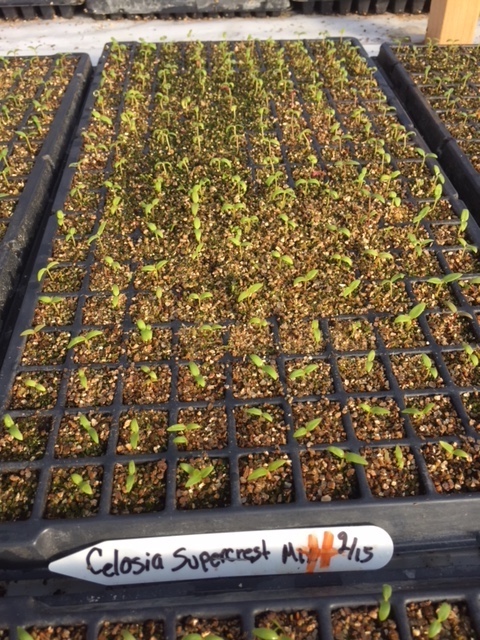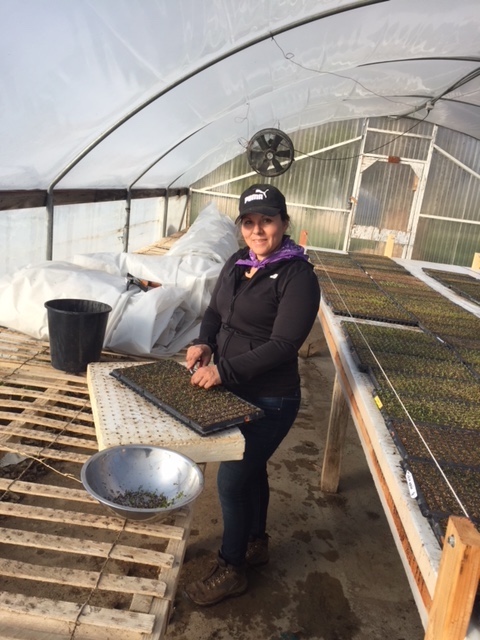I love my woodstove. Every cold night in winter, I fall more and more in love with the glow of fire, its warmth, comfort, and protection. So as I sit by the wood stove, penning this note, stoking another evening log into the firebox, I can’t help but wonder how the young and emerging seedlings out in the greenhouse are faring on this rapidly freezing night. With so many young plants, most of which are very cold sensitive, checking in on them like I did with my own children sleeping in the night, is pure instinct. After a week of substantially low temperatures and freezing weather, the safe haven of the greenhouses have been nearly breached, as heavy frost has encased the poly sheathed hoop houses and fatal cold has endangered plants closest to the outside walls. In the past, I have woken up to “frozen and fried plants” many times over the years, so I know that growing plants in a greenhouse is a 24/7 responsibility. Tonight, on this especially cold evening, I will check the greenhouse one more time before I go to bed.

Greenhouse season at Full Belly begins in earnest in January when in the de facto heart of winter, we urge seeds to defy shortness of day and breath of light to push growth from below to above. Germination is nothing short of miraculous. While science systematically explains the biological metamorphosis of germination, one remains awestruck at the fulfillment of potential with each germinated seed. This “fulfillment of potential” by late February means that greenhouses are beginning to fill with trays upon trays of young seedlings. The numbers begin to make your head spin — 100,000 tomatoes, 40,000 flowers, 90,000 onions, 30,000 leeks, 20,000 lettuce, 20,000 cabbage, 10,000 eggplant, 10,000 dino kale, 12,000 basil, and so on.
All of this work is expertly choreographed by our longtime tag team Chica Gaxiola (above) and Ana Cervantes (below), who have overseen production for more than a decade. Managing a greenhouse is a little bit like running a boarding house: everything is on a schedule and when it’s not, like when the weather changes, then you have to think on your feet. Each day, plants are awoken and uncovered on the hot benches when the sun comes up. Plants are watered and “fed” 1, 2, and sometimes even 3 times a day. Doors are opened and closed, and sidewalls are raised for ventilation, temperature and comfort. Plants are inspected and at the end of the day, hot benches are covered, plants tucked in, and doors closed, readied for the night. Sometimes we even put a little chocolate on their pillows!
 At day’s end Ana covers tomato flats on the heated bench. Note month-older tomatoes on side benches.
At day’s end Ana covers tomato flats on the heated bench. Note month-older tomatoes on side benches.
Given that the greenhouses are the most exclusive and in demand real estate on the farm, residency is at a premium. There is always a “waiting list” so to speak, as one succession of seedlings after another are scheduled for sowing. Greenhouse success is measured by how expediently and methodically we can go from seed to healthy plant stock ready for transplanting in the field. Unlike the production of widgets, growing plants in a controlled environment is anything but controllable. A good year in the greenhouse sees wave after wave of plantings move out to the field in a timely and routine manner. Those are typically years of patterned weather and predictable conditions. A bad year is when everything you thought after a lifetime of experience, doesn’t amount to enough. These are years of heavy disease pressure, unusually poor water quality, equipment failure, and sometimes just darn bad luck. There’s a lot at risk, as so much of the farm’s ultimate success starts in the greenhouse. Thankfully though, most of the time, we produce successions of reasonably healthy transplants with minimal travail and dereliction. As plants leave greenhouse to field, we send these little seedlings down a path to fulfill their destiny of abundance.
— Andrew Brait


